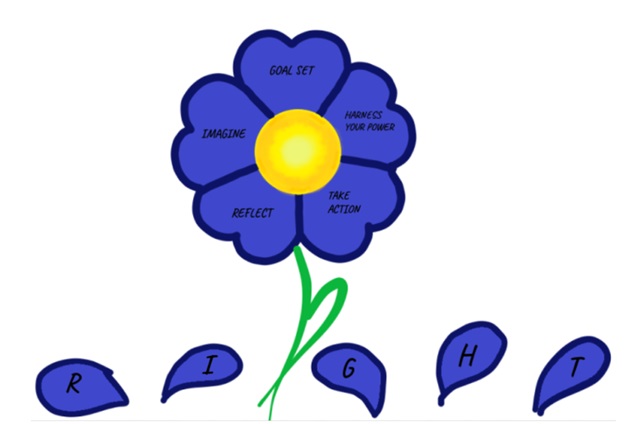A Coaching Model By Suzanne Martyn-Jones, Team Coaching/Team Coach, CANADA
Teamwork can be incredibly challenging given the different personalities, conflicting directions, and external pressures of being part of a team. When a team isn’t working well together, there is a feeling ‘in the air that makes it uncomfortable and stressful for everyone involved. And rather than trying to solve the issues, there is often a tendency to bury concerns or to hope that the situation will just magically improve. The reality is that the dynamics of the team won’t change unless a proactive approach is taken to make things better.
Getting it right is a coaching model that shifts the mindset of a team so that they can take control and accomplish more together. It drives a positive outcome, allowing the team to be united with purpose and fulfillment. The model is made up of five key steps and the flower analogy for the model depicts the feeling of ease that comes with getting it ‘right’.

Getting it right Coaching Model Influence
In the customer service industry, ‘Make it Right’ programs empower front-line representatives to correct customer service issues on the spot. Research shows that customers respond positively when efforts are made to apologize for an error by doing something special, or ‘right’. In fact, these efforts can often lead to an even better overall satisfaction with the company than before the mistake. The RIGHT coaching model takes a similar approach in turning around a bad situation into something better or even more optimal.

- How do you feel about this assignment? Have you tried something like this before?
- How do you plan to contribute to the team? Is this a new approach?
- What kind of participation do you expect from others? From yourself?
- How can you best work together? What have you learned so far?
- What excites you about the project or task? What concerns you?

To move forward, the team must imagine the possibilities of achieving something greater together than they could on their own. Here are some questions to ask when imagining the possibilities:
- How can we achieve transformation as a team? What would need to be true?
- What if we solved this problem? What would be different?
- How is the team more powerful together? What combined skills do we bring?
- Is it possible to tackle this problem?
- How can we best prepare ourselves as a team?

“The massive changes brought about by Covid-19 abruptly reminded…societies that there is great power when we work together and stay connected. A connection to something shared – a mission, purpose, or guiding star – can allow people to focus on something bigger.”[5]The importance of having a goal shouldn’t be underestimated, as it’s the anchor that keeps everyone on the team grounded in the same way. Without it, teams are left to flounder. Here are some questions to consider when setting goals as a team:
- What do we want to accomplish together?
- Why do we need to do this now? What is urgent about this goal?
- Is this goal SMART – specific, time-bound, achievable, realistic, and time-bound?
- What role will everyone play to achieve this goal?
- How will we know that we have been successful?

- What power do you have? How can you contribute them to the team?
- Are you ready to take on the task at hand? How can you display your expertise?
- Can you combine your skills with another team member to be even stronger?

- When is the team ready for action? What are the first steps?
- How is the team going to work together?
- What tasks need to be done? Who is the best to do them?
- When will the work be completed? How will we know?
- Can we accomplish what we set out to do?
“Collective efficacy is a shared belief that our team can succeed. Take two teams with equivalent talent and the one with greater collective efficacy will perform better.”[7]This efficacy doesn’t come automatically just because individuals are supposed to work in a group. It’s a shared belief that comes when a team grows together using a framework such as the RIGHT model. The end state is worth the effort, as teams that work cohesively are more effective, empowered, and prepared to achieve greater success.
The RIGHT model can be applied to individual situations as well as teams. Perhaps there is a job that isn’t the right fit, or a relationship that needs mending, or a period in life that is a struggle. Individuals can use the RIGHT coaching model to improve any situation– by reflecting on the past, imagining the possibilities, setting goals, harnessing their power, and, finally, taking action. Following these steps allows them to seize the challenge in front of them and move forward positively, reaping all the rewards that life has to offer.
References
Science of People: 5 Coaching Techniques to Turn Your Employees into All-Stars, by Vanessa Van Edwards
Harvard Business Review: 7 Strategies to Build a More Resilient Team, by Keith Ferrazzi, Mary-Clare Race, and Alex Vincent
Harvard Business Review: What Everyone Gets Wrong About Change Management, by N. Anand and Jean-Louis Barsoux
Harvard Business Review: The Secrets of Great Teamwork, by Martine Haas and Mark Mortenson
Harvard Business Review: 3 Tools to Help Leaders Steady their Teams during a Transition, by Victoria M. Grady
Forbes: Evidence-Based Strategies For Better Teamwork, by Kevin Kruse
[1]https://www.scienceofpeople.com/coaching-employees/
[2]https://www.hbr.org/2021/01/7-strategies-to-build-a-more-resilient-team
[4]https://www.hbr.org/2016/06/the-secrets-of-great-teamwork
[5]https://www.hbr.org/2021/03/3-tools-to-help-leaders-steady-their-teams-during-a-transition
[6]https://www.scienceofpeople.com/coaching-employees/
[7]https://www.forbes.com/sites/kevinkruse/
